#seleucus
Text
The elite bodyguard of Alexander the Great is said to have killed a lion with his bare hands and this is how he gained Alexander’s attention. This man was Lysimachus and he eventually had a small empire of his own.
#Lysimachus#Macedonian#Macedon#Macedonia#Alexander the Great#general#Greek#elite bodyguard#The Battle of Hydaspes#thrace#Wars of the Diadochi#Ptolemy I#Cassander#Seleucus#Antigonus#Diadochi#ancient#history#ancient origins
60 notes
·
View notes
Text
Based on this post from @suburbanbeatnik. There are some others that unfortunately I couldn't mention due to limited space, so I picked the most famous/the ones I liked the most.
#greece#ancient greece#greek history#history#history couples#alexander the great#hephaistion#seleucus#seleucis i nikator#apama#stratonice#antiochus i#pericles#aspasia#pelopidas#epaminondas#gorgo#leonidas#olympias#philip#socrates#xanthippe#phryne#praxiteles#harmodius#aristogeiton#cleopatra#perdiccas#it's pretty clear which couple is gonna win#ah well let's see who is gonna end up second place
10 notes
·
View notes
Photo

We’re not even ready for the Argead dynasty murder memes.
#perdikkas#seleucus#seleukos#meleager#ptolemy i soter#ptolemy keraunos#successor wars#wars of the diadochi#alexander the great#ancient greece#hellenistic period#ptolemaios#perdiccas#ancient history
17 notes
·
View notes
Text
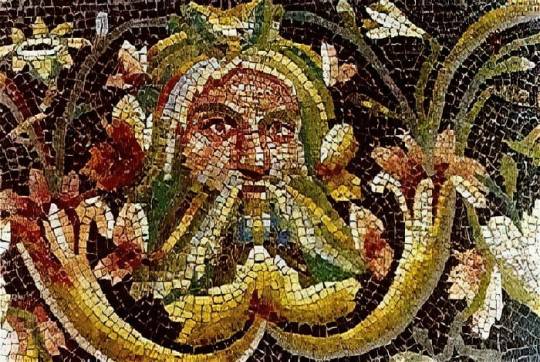
The Stunning Ancient Greek Mosaics of Zeugma
The ancient Greek mosaics of Zeugma in Turkey are true archaeological treasures that can still be admired at the Zeugma Mosaic Museum in Gaziantep, Turkey.
The 30,000-square-meter (320,000 square foot) museum, which opened its doors in September of 2011 is the largest mosaic museum in the world, containing 1,700 square meters (18,000 square feet) of ancient works of art.
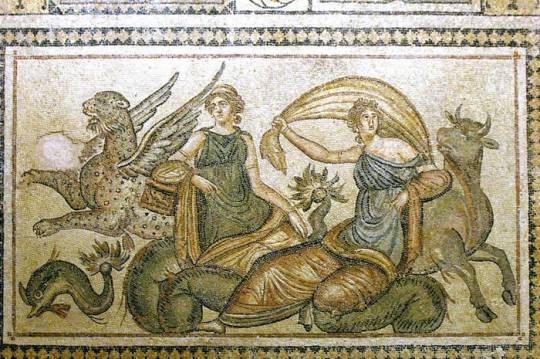
The museum focuses on the mosaics found in Zeugma, which was originally founded as Seleucia by Seleucus I Nicator, a general in Alexander the Great’s Army, in 305 BC.
After Alexander’s death, his generals divided his empire among themselves. Although Seleucus moved his main capital to Antioch, Seleucia became an important center of trade, Hellenistic culture, and regional government under the Seleucids.

The city was populated by Greeks, Syrians, and Jews. It was an affluent city with a population of eighty thousand and in the 2nd and 3rd century BC was of sufficient stature to be compared to another great center of Hellenism, Alexandria, in Egypt.
The Roman Empire’s forces conquered the city in 64 BC, renaming it Zeugma (meaning “bridge” or “crossing” in ancient Greek).
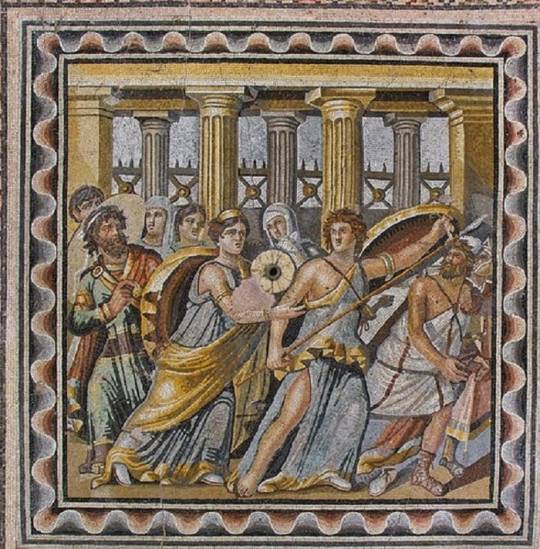
The Romans held Zeugma until 253 AD, when the Persian Sassanids conquered the city, putting a violent end to its most significant years.
The ancient Greek mosaics of Zeugma
The treasures of Zeugma, including its vaunted mosaics, remained relatively unknown until the year 2000. Zeugma is now eighty percent underwater after it was flooded with the waters of a nearby artificial lake.
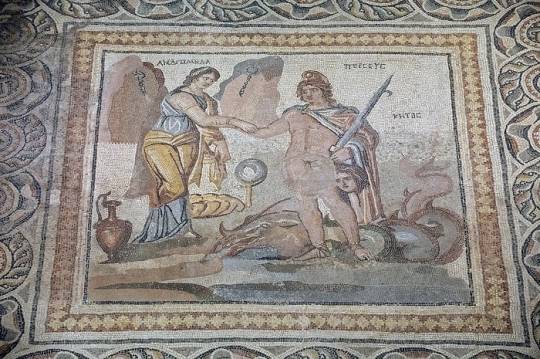
Archaeologists were alarmed at the flooding of the area and immediately began excavations to save the ancient treasures.
Most of the Greek mosaics of Zeugma, which were recovered in excellent condition, belong to the 2nd century BC preceding the Romans.

However, some of the mosaics appear to belong to the Roman era, as they depict Greek and Roman deities together.
In addition, some of the mosaics deviate from purely Hellenistic style and imagery, with archaeologists placing them in the Roman era of the city’s history.
The archaeological site of Zeugma
The archaeological site of Zeugma is a UNESCO World Heritage Center, located ten kilometers (six miles) away from Nizip within the boundaries of Gaziantep.
The preserved parts of the ancient city include the Hellenistic Agora, the Roman Agora, two sanctuaries, the stadium, the theater, two bathhouses, and the Roman legion military base.

Remains of the administrative structures of the Roman legion, the majority of the residential quarters, Hellenistic and Roman city walls, and the East, South and West necropolis can also be found there.
The archaeological site of Zeugma is of immense historical significance in the understanding of the ancient integration of Hellenistic and Semitic cultural spheres and the birth of syncretistic hybrid cultures in the region.
By Philip Chrysopoulos.
#The Stunning Ancient Greek Mosaics of Zeugma#Gaziantep Turkey#the largest mosaic museum in the world#Seleucus I Nicator#Alexander the Great#mosaic#ancient artifacts#archeology#archeolgst#history#history news#ancient history#ancient culture#ancient civilizations#roman history#greek history#greek art
145 notes
·
View notes
Text
Me looking into the family tree of the Syrian branch of the Severan Dynasty:

#ancient rome#roman empire#mark antony#most of the severans in the syrian branch are possible descendants of cleopatra vii and mark antony#septimius severus is the exception#this would mean the Syrian branch of the Severan dynasty are possible deacendants of the 2 generals that rode with alexander the great#that being ptolemy i soter and seleucus i nicator#also possibly descended from apama
7 notes
·
View notes
Text

The other day, @cuties-in-codices had a great question: why are so many elephants in medieval European manuscripts depicted with castles on their backs? Even today, there is the Elephant and Castle Underground Station in London (perhaps named after a pub). (Image source: x)
The iconography ultimately derives from descriptions of war elephants in ancient texts which were read, copied, and translated in northern Europe. One of the things I'm studying is how elephants featured prominently in medieval European art and poetry, even among people who had never seen one, and how these links can show intellectual networks and the long impact of north African and Asian writers on world literature.
There are records of elephants being used in war in a number of ancient contexts. The most famous examples today are the leaders of Carthage, including Hannibal, but they were also recorded in India and in connection to Alexander's successors. These stories from Plutarch, Orosius, and other ancient writers filtered down to northern Europeans, who imagined elephants carrying whole forts/castles on their backs. Stay tuned for more!

Coin of Seleucus I Nicator (d. 281 BC) showing a fantastical view of his chariot being pulled by elephants (British Museum, Coins and Medals 2002,0101.1329 )
#elephant#elephants#war elephant#london underground#tube station#elephant and castle#seleucus nicator#coins
7 notes
·
View notes
Text



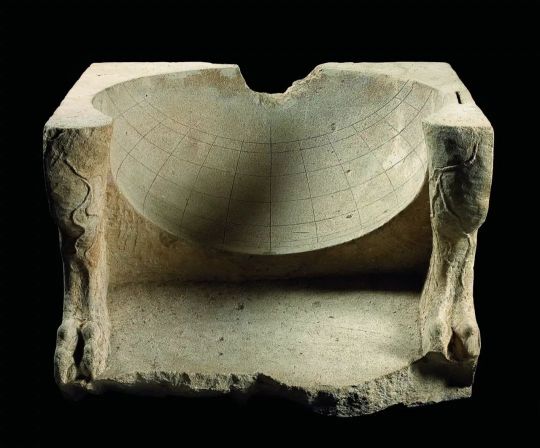
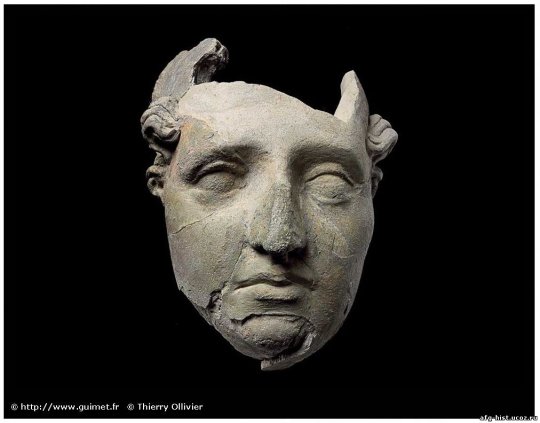
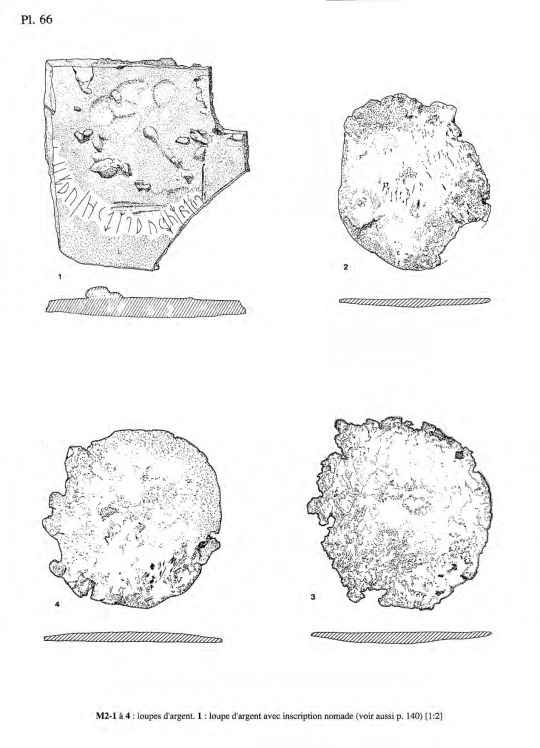

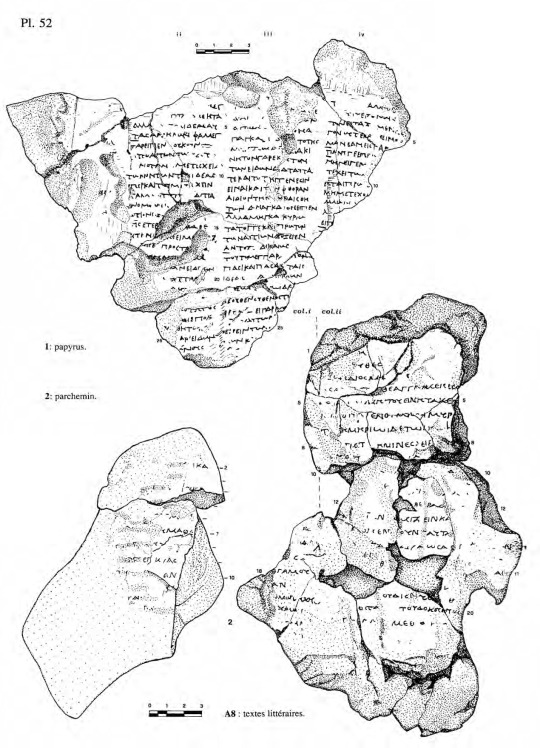
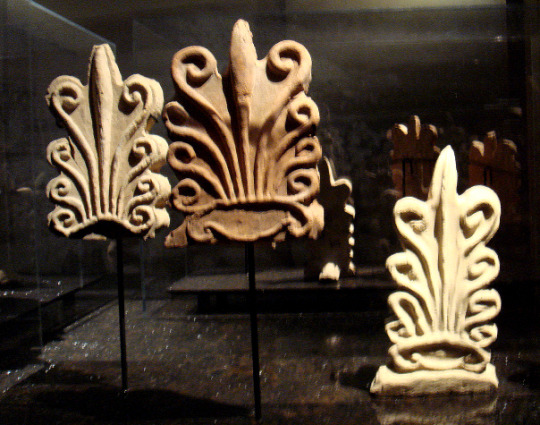





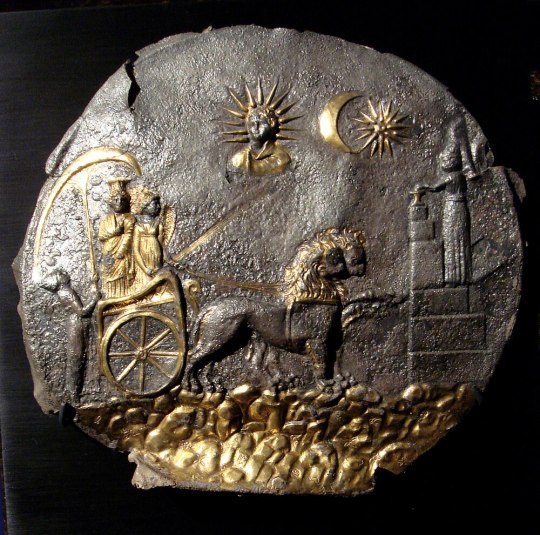

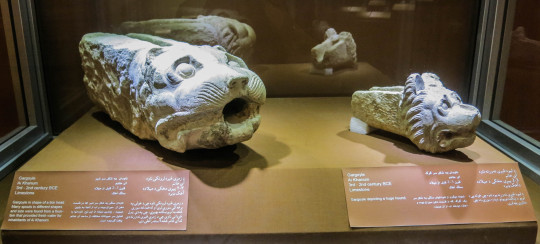

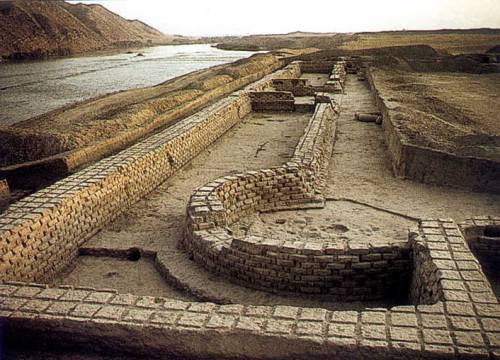



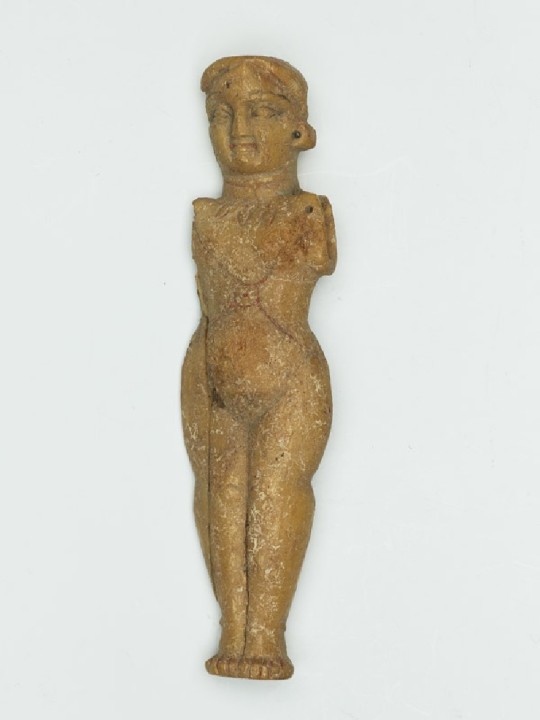





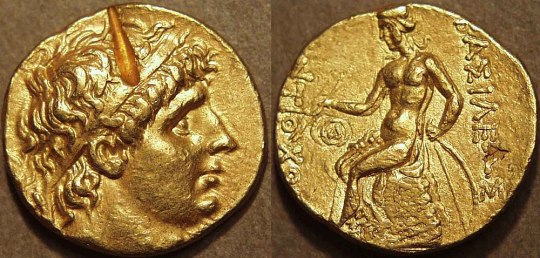

Ai Khanoum 3rd C. BCE - 2nd C. CE. More images on my blog, link at bottom.
"These wise sayings of men of old,
The words of famous men, are consecrated
At holy Delphi, where Klearchos copied them from carefully
To set them up, shining from afar, in the sanctuary of Kineas.
As a child, be well behaved;
As a young man, self-controlled;
In middle age, be just;
As an elder, be of good counsel;
And when you come to the end, be without grief.
—trans. of Ai Khanoum stele by Shane Wallace and Rachel Mairs.
Ai-Khanoum (/aɪ ˈhɑːnjuːm/, meaning Lady Moon; Uzbek Latin: Oyxonim) is the archaeological site of a Hellenistic city in Takhar Province, Afghanistan. The city, whose original name is unknown, was likely founded by an early ruler of the Seleucid Empire and served as a military and economic centre for the rulers of the Greco-Bactrian Kingdom until its destruction c. 145 BC. Rediscovered in 1961, the ruins of the city were excavated by a French team of archaeologists until the outbreak of conflict in Afghanistan in the late 1970s.
The city was probably founded between 300 and 285 BC by an official acting on the orders of Seleucus I Nicator or his son Antiochus I Soter, the first two rulers of the Seleucid dynasty. There is a possibility that the site was known to the earlier Achaemenid Empire, who established a small fort nearby. Ai-Khanoum was originally thought to have been a foundation of Alexander the Great, perhaps as Alexandria Oxiana, but this theory is now considered unlikely. Located at the confluence of the Amu Darya (a.k.a. Oxus) and Kokcha rivers, surrounded by well-irrigated farmland, the city itself was divided between a lower town and a 60-metre-high (200 ft) acropolis. Although not situated on a major trade route, Ai-Khanoum controlled access to both mining in the Hindu Kush and strategically important choke points. Extensive fortifications, which were continually maintained and improved, surrounded the city.
Many of the present ruins date from the time of Eucratides I, who substantially redeveloped the city and who may have renamed it Eucratideia, after himself. Soon after his death c. 145 BC, the Greco-Bactrian kingdom collapsed—Ai-Khanoum was captured by Saka invaders and was generally abandoned, although parts of the city were sporadically occupied until the 2nd century AD. Hellenistic culture in the region would persist longer only in the Indo-Greek kingdoms.
It is likely that Ai-Khanoum was already under attack by nomadic tribes when Eucratides was assassinated in around 144 BC. This invasion was probably carried out by Saka tribes driven south by the Yuezhi peoples, who in turn formed a second wave of invaders, in around 130 BC. The treasury complex shows signs of having been plundered in two assaults, fifteen years apart.
Although the first assault led to the end of Hellenistic rule in the city, Ai-Khanoum continued to be inhabited; it remains unknown whether this reoccupation was effected by Greco-Bactrian survivors or nomadic invaders. During this time, public buildings such as the palace and sanctuary were repurposed as residential dwellings and the city maintained some semblance of normality: some sort of authority, possibly cultish in origin, encouraged the inhabitants to reuse the raw building materials now freely available in the city for their own ends, whether for construction or trade. A silver ingot engraved with runic letters and buried in a treasury room provides support for the theory that the Saka occupied the city, with tombs containing typical nomadic grave goods also being dug into the acropolis and the gymnasium. The reoccupation of the city was soon terminated by a huge fire. It is unknown when the final occupants of Ai-Khanoum abandoned the city. The final signs of any habitation date from the 2nd century AD; by this time, more than 2.5 metres (8.2 ft) of earth had accumulated in the palace.
While on a hunting trip in 1961, the King of Afghanistan, Mohammed Zahir Shah, rediscovered the city. An archaeological delegation, led by Paul Bernard, unearthed the remains of a huge palace in the lower town, along with a large gymnasium, a theatre capable of holding 6,000 spectators, an arsenal, and two sanctuaries. Several inscriptions were found, along with coins, artefacts, and ceramics. The onset of the Soviet-Afghan War in the late 1970s halted scholarly progress and during the following conflicts in Afghanistan, the site was extensively looted."
-taken from Wikipedia
...
"The silver ingot engraved with runic characters found during the excavations of the Treasury could suggest they were Sakā/Sai. This inscription comprises 21 characters of a script and a language that are unknown and both attributed to nomadic people of Sakā origin, by comparison with a dozen similar inscriptions coming from an area extending from Ghazni in Afghanistan to Almaty in Kazakhstan, and dated between the 5th century BC and the 8th century AD."
-taken from Ai Khanoum after 145 BC: The Post-Palatial Occupation by Laurianne Martinez-Sève, University of Lille, 2018
#ancient history#antiquities#art#paganism#statue#museums#sculpture#history#greek art#greek gods#ancient greek#greek myth#scythian#pagan#ancient art#afghanistan
186 notes
·
View notes
Photo
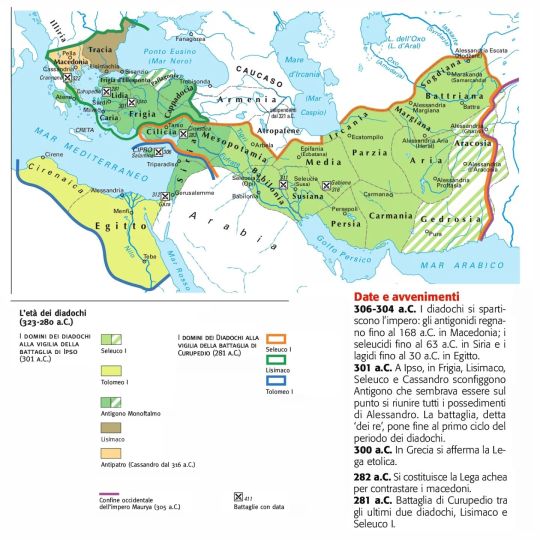
The Hellenistic world
"Atlante storico tascabile", Istituto Geografico De Agostini, Novara,1999
via cartesdhistoire
In 323 BC, Alexander died without heirs, possibly from the plague. His empire, already facing insurrectionary movements, did not outlive him. His generals, the Diadochi, began a protracted struggle for power: Antipater in Macedonia, Lysimachus in Thrace, Ptolemy in Egypt, Antigonus Monophthalmos in Asia Minor and Syria, and Seleucus in Babylon.
The first phase of the war among the Diadochi concluded at Ipsus in Phrygia in 301 BC, with the "battle of the kings." Lysimachus, Seleucus, and Cassander, son of Antipater, defeated Antigonus, who had been consistently victorious until then. Seleucus and Ptolemy, prudent rulers, founded dynasties destined for long endurance, even though they were not immune to the temptation of rebuilding Alexander's empire. The focal point of the conflict became Macedonia, and long wars ensued for its dominion.
The Epigones, successors of the Diadochi, instead supported the status quo. The kings of Egypt and Syria founded new cities, respecting the rights of existing poleis.
Nearly all Hellenistic kings surrounded themselves with scholars, artists, and scientists. Ptolemy I founded the largest library of antiquity in Alexandria, Egypt.
In 277 BC, the Galatians, of Celtic descent, settled in Asia Minor. Some provinces declared independence, including the kingdom of Pergamon, a city renowned for being built on terraces, distinguished by the splendor of its culture and art, exemplified by a library of 400,000 volumes.
The kingdom of Bactria, situated in the northern region of present-day Afghanistan, was also significant, representing the eastern extent of Hellenistic influence and serving as a crossroads between the cultures of the Mediterranean region and those of China and India.
Antiochus III, the greatest of the Seleucids, expanded the empire's territories. However, the invasion of Greece in 192 BC triggered a war with Rome. Following the war, the king was compelled to accept peace, marking the beginning of the inexorable decline of his empire.
84 notes
·
View notes
Text
The Selection || Loki x Reader || Masterlist and Selected list ||
~~~~~~~~~~~~~~~~~~
The Selection came around again and this year, you were eligible to sign up for it. You didn't want to, of course, coming from a family that barely got by through the winter and knowing that the Royals had no idea how much people like you suffered. However, your little sister signed you up and now your name is called on the television as one of the lucky twelve to move to the capital and begin the games to winning the Prince's heart.
Two years ago, the Selection had televised Prince Thor's journey to finding a wife. This year, it was Prince Loki's turn.
Prince Loki. The 'Dark Prince', not seen a lot in public other than the times that Prince Thor dragged him outside. Closed off. Self-centred. Arrogant. Right?
Follow Y/N through her journey from beginning to end. With eleven other contestants, will you win Prince Loki's heart?
~~~~~~~~~~~~~

Chapter One ~ Chapter Two ~ Chapter Three ~ Chapter Four ~ Chapter Five ~ Chapter Six ~ Chapter Seven ~ Chapter Eight ~ Chapter Nine ~ Chapter Ten ~ Final Chapter ~
~~~~~~~~~~~~~
Selected List:
Y/N Y/L/N – Brekstad, Midgard – didn’t really want to be Selected
Cleo Dameerin – Fetsheim, Vanaheim – there for love – 19 (533)
Phoebe Meera – London, Midgard – wishes to make friends – 22
Lorelei – Durdnheim, Vanaheim – there for the money – 18 (500)
Sophia De Mareen – Alzara, Alfheim – there for money 24 (645)
Chloe Olsen – Raneer, Asgard – there for money – 18 (474)
Adriana Sirandrew – Quolequeel, Jotunheim – wishes for love 21 (675)
Regan Seleucus – Soleheim, Niflheim – there for love or money 23 (50)
Isabel Bates – Adelaide, Australia – needs money for family – 20
Lara Oneal – Helian , Helheim – there for love – 25 (1500)
Summer Parkerdottir – Illias, Asgard – there for money 19 (520)
Katerina Godding – Essex, Midgard – there for status – 24
#loki laufeyson#tom hiddleston#enemies to friends to lovers#loki x reader#loki fluff#loki x reader fluff#loki x reader smut#loki smut#loki laufeyson x reader#hot loki#mcu loki#tom hiddleston character x reader#lokismut#loki x female reader#loki fanfiction#loki x yn#loki x female reader smut#loki imagine#loki oneshot#loki series#loki x you#loki (marvel)#loki
619 notes
·
View notes
Photo

Achaemenid Kings List & Commentary
The Achaemenid Empire (c. 550-330 BCE) was the first great Persian political entity in Western and Central Asia which stretched, at its peak, from Asia Minor to the Indus Valley and Mesopotamia through Egypt. It was founded by Cyrus II (the Great, r. c. 550-530 BCE) whose vision of a vast, all-inclusive Persian Empire was, more or less, maintained by his successors.
The Persians arrived in the region of modern-day Iran as part of a migratory group of Aryans (meaning “noble” or “free” and referencing a class of people, not a race). The Aryans – made up of many tribes such as the Alans, Bactrians, Medes, Parthians, and Persians, as well as others – settled in the area which became known as Ariana (Iran) – “the land of the Aryans”. The tribe which eventually became known as the Persians settled at Persis (modern-day Fars) which gave them their name.
Artaxerxes V (r. 330-329 BCE) was the short-lived throne name of Bessus, satrap of Bactria, who assassinated Darius III and proclaimed himself king. Alexander the Great found the dead or dying Darius III (the original accounts vary on this) in a cart where Bessus had left him and gave him a proper burial with all honors. Afterwards, Alexander had Bessus executed and took for himself the honor of the title Shahanshah, the king of kings of the Achaemenid Empire.
Conclusion
Although the Achaemenid Empire was no longer what it had been under Darius I, it was still intact when Alexander conquered it. He attempted a synthesis of Greek and Persian cultures by marrying his soldiers to Persian women, elevating Persian officers to high rank in his army, and comporting himself as a Persian king. His efforts were not appreciated by the Greek/Macedonian army and, after his death in 323 BCE, his vision was abandoned. Since he had named no clear successor at the time of his death, his generals went to war with each other to claim supremacy.
These wars (known as the Wars of Diadochi, 322-275 BCE), resulted, in part, in the rise of the Seleucid Empire (312-63 BCE) under Alexander's general Seleucus I Nicator (r. 305-281 BCE). The Seleucid Empire occupied approximately the same regions as the Achaemenid and, though it rose to a position of strength, gradually lost territory, first to the Parthians and then later to Rome. The Seleucids were succeeded by the Parthian Empire (247 BCE- 224 CE) which fell to the Sassanian Empire (224-651 CE). The Sassanians revived the best aspects of the Achaemenid Empire and would become the greatest expression of Persian culture in the ancient world.
The Sassanian Empire preserved the culture of the Achaemenids and, even after its fall to the invading Muslim Arabs, this culture would endure and spread throughout the ancient world. Many aspects of life in the modern day, from the seemingly mundane of birthday parties, desserts, and teatime to the more sublime of monotheism, mathematics, and aspects of art and architecture, were developed by the Sassanians drawing on the model of the Achaemenid Empire.
Continue reading...
32 notes
·
View notes
Text
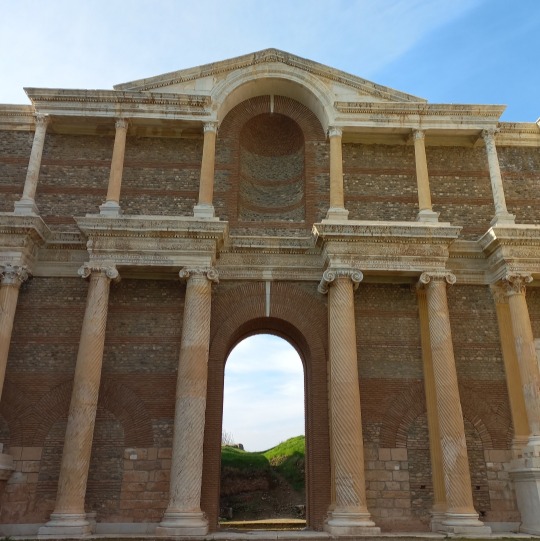


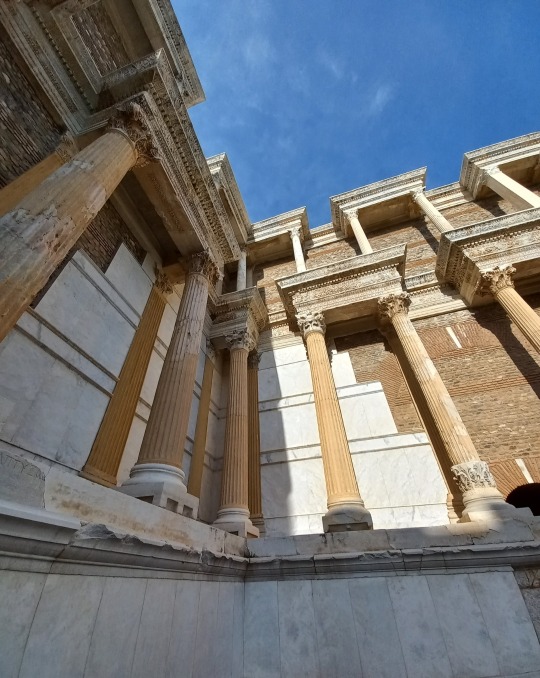

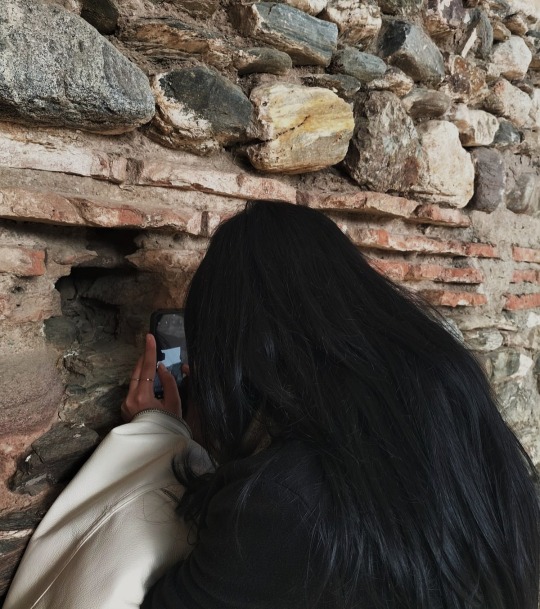


Sat, Jan 12 - I visited the ancient Roman city of Sardes today for the first time. (Information about the city is under this post.) It consisted of the Gymnasium with the remains of many Byzantine shops including restaurants and painting shops, a public pool, tombs, and a Synagogue. It was truly refreshing to see the place overall, but what I adored about the visit was the fact that you could imagine and experience the feeling of what it was like to be living in an ancient city, as it was empty because of the weather conditions. No voices, no noise, no motion, just the smell and the air of this ancient place. (I bet Henry Winter would die for it.) The Temple of Artemis was also close and I went there as well. I'll publish the pictures from the Synagogue and the Temple next if you want to check them out.
Sardis (/ˈsɑːrdɪs/ SAR-diss) or Sardes (/ˈsɑːrdiːs/SAR-de ess; Lydian: 𐤳𐤱𐤠𐤭𐤣, romanized: Sfard; Ancient Greek: Σάρδεις, romanized: Sárdeis; Old Persian: Sparda) was an ancient city best known as the capital of the Lydian Empire. After the fall of the Lydian Empire, it became the capital of the Persian satrapy of Lydia and later a major center of Hellenistic and Byzantine culture. It is now an active archaeological site in modern-day Turkey, in Manisa Province near Sart.
In 334 BC, Sardis was conquered by Alexander the Great. The city was surrendered without a fight, the local satrap having been killed during the Persian defeat at Granikos. After taking power, Alexander restored earlier Lydian customs and laws. For the next two centuries, the city passed between Hellenistic rulers including Antigonus Monophthalmos, Lysimachus, the Seleucids, and the Attalids. It was besieged by Seleucus I in 281 BC and by Antiochus III in 215-213 BC, but neither succeeded at breaching the acropolis, regarded as the strongest fortified place in the world. The city sometimes served as a royal residence, but was itself governed by an assembly.
In this era, the city took on a strong Greek character. The Greek language replaced the Lydian language in most inscriptions, and major buildings were constructed in Greek architectural styles to meet the needs of Greek cultural institutions. These new buildings included a prytaneion, gymnasium, theater, hippodrome, and the massive Temple of Artemis still visible to modern visitors. Jews were settled at Sardis by the Hellenistic king Antiochos III, where they built the Sardis Synagogue and formed a community that continued for much of Late Antiquity.
In 129 BC, Sardis passed to the Romans, under whom it continued its prosperity and political importance as part of the province of Asia. The city received three neocorate honors and was granted ten million sesterces as well as a temporary tax exemption to help it recover after a devastating earthquake in 17 AD.
Sardis had an early Christian community and is referred to in the New Testament as one of the seven churches of Asia. In the Book of Revelation, Jesus refers to Sardians as not finishing what they started, being about image rather than substance.
I take the pictures that are on my blog myself. In case you're interested in this post, I also post/reblog content including travel/cultural pictures, books, book recommendations, analysis, quotes, anything related to movies, series, and girl blog entries.
#sardes#ancient rome#ancient greek#gymnasium#ancient history#ancientmonuments#roman architecture#archeology#blog#travel#history#the secret history#henry winter#synagogue#dark academia#aesthetic#light academia#books#girlblogging#hellenistic#reading#if we were villains
35 notes
·
View notes
Text
The elite bodyguard of Alexander the Great is said to have killed a lion with his bare hands and this is how he gained Alexander’s attention. This man was Lysimachus and he eventually had a small empire of his own.
#Lysimachus#Macedonian#Macedon#Macedonia#Alexander the Great#general#Greek#elite bodyguard#The Battle of Hydaspes#thrace#Wars of the Diadochi#Ptolemy I#Cassander#Seleucus#Antigonus#Diadochi
41 notes
·
View notes
Photo
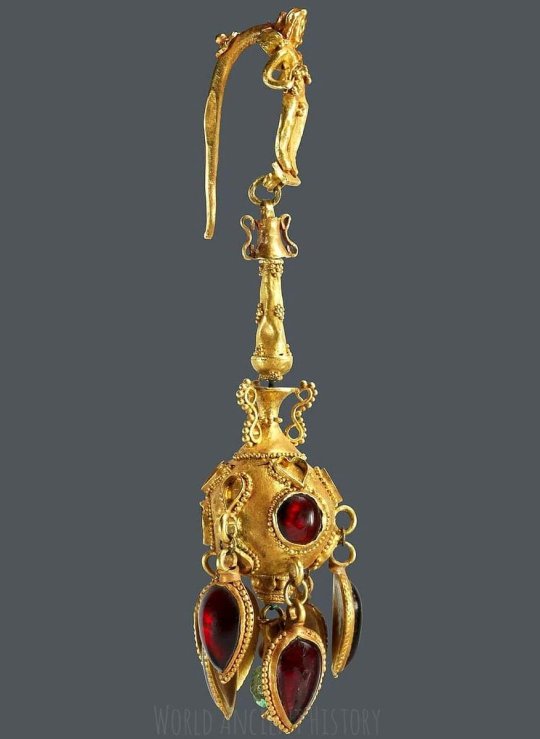
Greek Gold Earring (305-224 BC), from Mesopotamia; belonged to Seleucid Empire. A winged, naked Eros stands upon a kantharos cup (wine/offerings cup) which sits over an alabastron vase (container used for perfume and oils). Below, the earring ends in the shape of an Amphora vase (Pithos - storage vase), decorated with Garnets.
Seleucid Empire (Kingdom, as it is referred to in Hellenic) was a Greek power in West Asia during the Hellenistic period. Founded in 312 BC by the Macedonian general Seleucus I Nicator, it began after the division of the Macedonian Empire of Alexander the Great, and ruled by the Seleucid dynasty until its annexation by the Roman Republic under Pompey in 63 BC.
(H: 8.3cm) Louvre Museum
35 notes
·
View notes
Note
OK, so the more I think about it the more I realize that our girl (in TLQ) is just kinda expected to have kids, especially a son. It's mentioned in the conversation between Alexander and Hephaestion before the wedding and later between Alexander and reader before the wedding night 'activities'. Perdiccas also seems to have fantasies about starting a family with her, so yeah. No pressure!
I've been curious as to why she hasn't told Alexander that she's pregnant. My best guess is that she's still hoping that she'll be able to go home soon. Telling him would kinda cement her there. Alexander would no doubt be thrilled, but he'd also become 1000x more protective of her and make it harder for her to go back, especially since she's basically carrying the future of his empire. That's just my personal theory, though. Also, I think the other Macedonian officer who knows (besides Perdiccas) is Selucus. IDK, he hasn't shown up yet in TLQ and his story is an interesting one, especially the relationship with his wife 😍. But again, it's just my theory...
In any case, we already know (spoiler!) that reader will eventually produce two healthy babies, including a son, so she will certainly do her 'wifely duties' in that regard. And Alexander having a clear heir and successor with change everything. No doubt her children will be one of the most famous sets of twins in history. It may also draw some mythological parallels if her daughter is born first (like Apollo and Artemis). Either way, I'm looking forward to seeing more of them. They honestly sound adorable 🥰!
Anyway, I'm really, really looking forward to the release of chapter 12, when you get to it ofc. Until then, have a good week ❤️!
--O-
Everyone wants the poor girl pregnant... But don't they think about whether she wants to be pregnant? No, they don't think and they don't care...
In chapter 13 it will be explained why she didn't reveal her pregnancy, mainly because it will be more focused on Alexander! Yes, it is! Besides, he would be much more overprotective if she knew about the pregnancy, which would make it more difficult to kidnap her. Now the poor girl wonders if it was a good idea to hide her pregnancy.
Well, chapter 12 has already been posted and the official who knows about her pregnancy has already appeared! Spoiler, it's Seleucus and one more!
I hope you like chapter 12, anon! I love reading your comments!! ❤️ Have a good week too! 🫶🏻
16 notes
·
View notes
Text




The 8-day Jewish celebration known as #Hanukkah or #Chanukah begins today
The story:
2000 years ago the land of Israel was part of the Syrian-Greek Empire. Antiochus III, the King of Syria and his son Seleucus oppressed the Jews in the land of Israel.
That time, the Jewish Hellenists (Jews who accepted idol-worship and the Syrian-Greek way of life), while a tiny minority, have been amplified by the Greeks as they tokenized themselves against the Jewish people’s right to live as free people and as their own Jewish identity in the land of our ancestors (anti-Zionist Jews).
One day the henchmen of Antiochus arrived in the village of Modiin where Mattityahu, the old priest, lived. He built an altar and demanded that Mattityahu offer sacrifices to the Greek gods. Mattityahu refused.
One Hellenistic Jew approached the altar to offer a sacrifice, but Mattityahu stopped him and destroyed the altar.
Mattityahu knew that Antiochus would be enraged so he fled together with his sons and friends to the hills of Judea.
Many courageous Jews joined them and formed a rebellion. Before his death, Mattityahu called his sons together and urged them to continue to fight. In waging warfare, he said, their leader should be Judah the Strong. Judah was called "Maccabee," a word composed of the initial letters of the four Hebrew words מי כמכה באלים ה׳, "Who is like You, O God.”
Later, Antiochus sent his General Apolonius to wipe out Judah and his followers, the Maccabees. An army consisting of more than 40,000 men swept the land.
When Judah the Maccabee heard it, he said: "Let us fight unto death in defense of our souls and our Temple!"
The war was won and the Maccabees returned to Jerusalem, entered the Temple and cleared it of the idols placed by the Syrian vandals.
Since the golden Menorah had been stolen by the Syrians, the Maccabees now made one of cheaper metal.
There was only a small cruse of pure olive oil, which was sufficient to light only for one day. Yet, it continued to burn for 8 days. In the memory of the miracle, our sages appointed these eight days for annual thanksgiving and for lighting candles
Hen Mazzig
200 notes
·
View notes
Text
Ptolemaic Gondor?
Tolkien named Ancient Egypt as one of the inspirations for Gondor-particularly aesthetically and in their capacity for grand architecture. The crown of Gondor also resembles the crown of Upper Egypt, tall and conical, with similar symbolism between the combining of the crowns of Upper and Lower Egypt and the combination of the Gondorian crown with the Arnorian diadem-the Elendilmir. I think there is also a deeper link between Gondor and Ancient Egypt, particularly Egypt under the Ptolemaic dynasty, the last to rule Egypt before the Romans annexed it.
Under the cut for a brief history of Ptolemaic Egypt and what that has to do with Gondor!
The Ptolemies were descended from one of Alexander the Great’s generals, called, unsurprisingly, Ptolemy. Alexander and his army were from Macedon, a northern Greek kingdom. In the chaos after Alexander’s death his generals carved up his empire, with Ptolemy rushing to Egypt and having himself proclaimed Pharaoh. The Ptolemaic dynasty ruled from Alexandria, a city founded by Alexander in the Nile delta, on the shores of the Mediterranean. Ptolemy was a Macedonian, and many other Macedonians, both soldiers of Alexander and others, followed them to Egypt. Alexandria became a great centre of Greek Hellenic culture dominated by Macedonians, who became basically a ruling class of this new Ptolemaic state. The highest offices of government were reserved for Macedonians, Macedonian Greek was the court language, the military was made up (at first at least) of Macedonians and mercenaries, with no recruitment from the Egyptian population. The traditional Egyptian religion and the role of the Pharaoh within it remained (with some Greek introductions), but in most other things Macedonians and their customs dominated. No Ptolemaic Pharaoh even knew how to speak Egyptian until Cleopatra VII (yes, that’s THE Cleopatra), the last ruler of the dynasty! Even she seems to have done little to better integrate Egyptians and Macedonians, with the Macedonians remaining firmly in charge until the Romans annexed Egypt.
Now the Ptolemies were not the only successors of Alexander, and one of their main rivals were the Seleucid empire, founded by fellow Macedonian general Seleucus. The Ptolemies often fought for control of the Levant in the Syrian wars. During the reign of Ptolemy IV the Ptolemies and Seleucids were embroiled in the fourth Syrian war. Faced with manpower shortages within the Macedonian ruling class, Ptolemy IV’s army included Egyptians trained to fight in the Macedonian style as part of the phalanx. At Raphia, Ptolemy IV won a decisive victory, with the Egyptian troops playing a key role in the battle. While this did improve the lot of Egyptians within Ptolemaic Egypt, Macedonians continued to dominate both the state and the military, and the failure to further integrate Egyptians into the army contributed to the weakening of the Ptolemaic state, which enjoyed arguably its finest hour at Raphia. A succession of poor rulers and civil war would see the state decline, eventually being annexed into the Roman empire after the death of Cleopatra VII.
Now, how does that fit with Gondor?
Gondor was founded by Númenorian exiles, with a Númenorian ruling class. Its main languages are Westron (descended from Númenorian Andunaic) and Sindarin, a common language among certain Númenorian communities. Comparisons may be made between Alexandria and cities like Pelagir and Osgiliath as centres of Númenorian dominance and culture (Pelagir especially, there is a reason Castamir liked it so much). And, like Ptolemaic Egypt, it seems like Númenorians dominated the military, with other peoples excluded. To quote Faramir:
“But the stewards were wiser and more fortunate. Wiser, for they recruited the strength of our people from the sturdy folk of the sea-coast, and from the hardy mountaineers of Ered Nimrais.”
This would seem to imply that prior to this, these peoples were excluded, and Númenorians dominated the military. But the Gondorians learned their lesson, at least to a greater degree than the Ptolemies did, and were able to slow their decline by better integrating non-Númenorians into the state. Númenorians still hold the highest positions of power (Denethor and Imrahil are the two most powerful men in the country in the late third age, both are Númenorians), but military discrimination is at least heavily reduced.
The appendices and unfinished tales do say that Northmen were recruited into the Gondorian military after the Kin-Strife, and mentions them in Eärnur’s army sent to fight Angmar. These may have been analogous to the mercenary forces used by the Ptolemies, rather than representing a widening of recruitment (though many Northmen did settle in Gondor after the Kin-Strife).
Obviously the comparisons are not 1:1, but I think early Gondor may well have resembled Ptolemaic Egypt in the structure and stratification of society. I suspect that this began heavily breaking down after the Kin-Strife. For a start, a lot of Númenorians are dead, or have been forced to renounce their ancestry by Eldacar. The Gondorians will need to look elsewhere for a supply of manpower. Númenorian supremacy may well start being seen as treasonous due to Castamir’s actions, and an active threat to the continued existence of the Gondorian state. By Denethor II’s time the Gondorian army seems far more diverse, and even many of the aristocrats may well be non-Númenorian (though again, Denethor and Imrahil occupy the most powerful positions).
#gondor#lotr#lotr meta#my posts#I've seen people compare Númenorian imperialism to modern imperalism like that of the european states from 1600-1900s#While I think that fits for Númenor I don't think it quite works for Gondor#Ptolemaic-like Gondor seems to fit much better with how this society works-it's very much not like anything from the modern period to me#also apologies if I made any historical mistakes#I'm not a historian or an expert on ptolemaic egypt to feel free to correct me if I got anything wrong#I just think ptolemaic egypt is an interesting comparison for what we know about gondor
34 notes
·
View notes